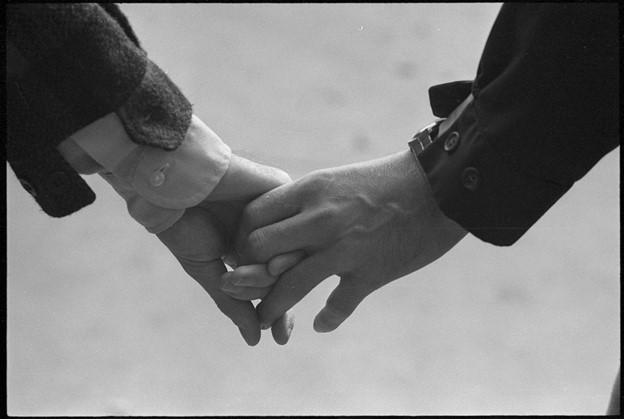The world’s largest online family history resource - Start now
-
Using DNA to Trace Your African American Heritage -
Daisy Bates Day in Arkansas -
Black History Month – Ancestry Initiatives to Honor Black Heritage -
Marking 80 Years Since Auschwitz Liberation: Our Commitment to Holocaust Remembrance
GET THE LATEST
New posts + monthly newsletter.
GET THE LATEST
New posts + monthly newsletter.
For most people, Valentine’s Day brings up memories of frilly Valentine’s card exchanges, chalky conversation hearts, or chocolates and roses exchanged between lovers. Valentine’s Day is about celebrating your special someone, whether they’re a new partner or a decades-long spouse. It can also be a day of honoring and exploring the love stories of your relatives who helped make your family what it is today.
As lovey-dovey as the holiday is now, the true Valentine’s Day history has a much more complex beginning. Learn more about the origins of Valentine’s Day before it became the holiday of love.
Why Is Valentine’s Day Celebrated?
Valentine’s Day history isn’t as straightforward as you might think. Historians have different opinions about where the holiday originated.
One of the events that’s often mentioned is Lupercalia, an ancient Roman festival held in February. This festival wasn’t focused on love, though. It was a pagan festival centered on increasing fertility and is a part of the less commercial history of Valentine’s Day.
Occurring on February 15, Lupercalia traced its origins to religious rites in ancient Greece dedicated to the Lycian god Pan, whom the Romans called Lupercus.
Others attribute this festival to the legend of Romulus and Remus, a pair of twins ordered to be thrown into the Tiber River by their uncle, King Amulius. However, a servant chose to place them in a basket to float down the river instead. According to legend, the god of the river carried them to a tree, where it was caught in the low-hanging branches, and the infants were found by a wolf at the base of Palatine Hill–a location that would become Rome.
The brothers were eventually adopted by a shepherd, and when they learned that their uncle had called for their deaths, they took their revenge before returning to the den the wolf nurtured them in and named it Lupercal. Some say Luperalia is to honor the wolf while others believe it’s to please Lupercus.
Many of the rites of Lupercalia took place in the area around the cave the brothers named Lupercal. They featured less innocent rituals such animal sacrifice and excessive drinking, as well as a massive feast. Men would also draw the names of women from jars and customarily stay together for the year, with many falling in love and choosing to marry.
Another common story that moves away from Valentine’s Day’s Pagan origin is that of St. Valentine. It brings a Christian element to the holiday’s beginning.
The Legend of St. Valentine

The Valentine’s Day history facts related to St. Valentine are a little fuzzy. That’s partially due to there being several martyred saints with the name Valentine or Valentinus. One story is about a priest named Valentine, who married couples secretly against a decree from Emperor Claudius II. However, due to his religious ties and eventual refusal to abandon his faith, Valentine was put to death.
A bishop named St. Valentine of Terni was a bishop who was also put to death by Claudius II. Many people point to him as the inspiration for the modern heart-filled holiday.
Still, another story talks of an imprisoned Valentine who wrote a love letter to a girl who visited him in prison. The legend says he signed it “From your Valentine,” making it the origin story for Valentine’s Day cards.
Some people believe the push to give a saint named Valentine credit for the holiday was to cover up the pagan past. It added a Christian twist to the less than sweet rituals found in Valentine’s Day’s past.
So, how did Valentine’s Day go from pagan rituals and martyred saints to love and romance? Some of the legends surrounding saints named Valentine related to love, such as the priest who married couples in secret or the jailed Valentine who confessed his love in a written note.
Another link between Valentine’s Day history and romance is Geoffrey Chaucer, an English poet who wrote Parliament of Fowls in 1375. In it, he draws a connection between the saints and love.
Is Valentine’s Day a Pagan Holiday?
Whether Valentine’s Day is considered a Pagan or Christian holiday depends on who you ask. Although many celebrants now view Valentine’s Day solely as a commercial holiday, some religions forbid members from participating in this celebration of love altogether.
Ultimately, Valentine’s Day history is open to interpretation, meaning everyone gets to decide for themselves which parts they believe in. You can decide whether it aligns with your values and beliefs if you choose to celebrate it.
Valentine’s Day Meaning and Symbolism
Perhaps one of the most notable symbols of the holiday is the Valentine’s card. Formal messages of love date back to the 1500s. But it was centuries later in the late 1700s when commercially printed Valentine’s cards made an appearance.
Commercially printed cards in the United States became more readily available in the 1840s. That’s when printing presses became cheaper and paper production jumped. When Hallmark opened in 1911, affordable cards with more textured and colored designs became available.
Other common Valentine’s symbols include:
- Hearts: The idea of the human heart being related to love comes from poets and authors talking about hearts beating while falling in love. The origin of romantic heart shapes isn’t as clear. It could be based on the seed shape of silphium, the shape of human buttocks, or Aristotle’s description of human hearts as symmetrical.
- Cupid: He might look like a baby, but Cupid is based on the god of erotic love. Cupid is the Roman name, while the Greeks called their god of love Eros. The cherub image of Cupid remained a popular representation of love, even when Roman gods were overshadowed by Christianity.
- Birds: If you and your significant other have been referred to as love birds, you can thank Chaucer and his Parliament of Fowls poem. It talks about birds singing love songs as winter fades.
- Roses: Flower symbolism gained popularity in England during the 18th and 19th centuries. While red roses dominate as the go-to Valentine’s Day flower today, Victorian-era choices included red carnations and tulips.
Valentine’s Day Facts
No matter how Valentine’s Day started, the holiday has lots of fun facts associated with it. For instance, spending on Valentine’s Day in 2022 was estimated at $23.9 billion, according to the National Retail Federation. Data also shows that within the past consecutive years, over 50% of consumers in the United States planned to celebrate the holiday of love.
Another fun fact is the origin of decorative Valentine’s Day cards. Esther Howland earns the credit as the mother of the American Valentine. She created Valentine’s cards that replicated beautiful versions from England and hired local girls to help make them. Her brother helped her find customers.
Candy and chocolate became more popular for Valentine’s Day in the 19th century. At that time, chocolate could be made faster and for a lower price. Chocolatier Richard Cadbury quickly started designing his own boxes for the company’s treats, making him the possible founder of the heart-shaped box.
Valentine’s Day Traditions Worldwide

Valentine’s Day celebrations center around love worldwide, but they often vary slightly in their specific focus. Some countries and cultures also have unique gifts or traditions that they incorporate into their celebrations. A sampling of Valentine’s celebrations from around the world include:
- Japan: On February 14, women give chocolate to men. The men in platonic relationships, such as friends or coworkers, receive giri choco from women, while romantic interests receive honmei choco. On March 14, the roles reverse and men give women chocolate.
- South Korea: Traditions are similar in South Korea with men receiving chocolates and flowers on February 14 and women getting their turn on March 14.
- Ghana: The cocoa bean is Ghana’s top agricultural export and gets all the attention on February 14. Known as National Chocolate Day, it’s celebrated with events dedicated to chocolate.
- Germany: As a symbol of luck and lust, pigs often make an appearance in Valentine’s Day gifts in Germany. Heart-shaped ginger cookies are also popular.
- Denmark: Valentine’s Day often includes joking letters sent anonymously to crushes. Guessing the sender correctly means the recipient gets a chocolate Easter egg.
- Brazil: Brazilians celebrate Dia dos Namorados, or Lovers Day, on June 12.
As you can see, most Valentine’s Day celebrations happen on February 14, but there are some exceptions. There are also many ways to show love. While many countries focus on romantic love, it’s also common to involve friends, coworkers, and bosses.
Connecting With Loved Ones on Ancestry®
Despite its possibly dark origins, Valentine’s Day is now considered to be a day for romance. But the holiday isn’t just about love connections. It’s also about loved ones, past and present. You can use Valentine’s Day as inspiration for learning more about your family. Try exploring relationships and marriages of your ancestors by searching for their marriage announcements from Newspapers.com™ to see if you find details about their big day. Or, you can build a family tree with a loved one. You might even gift an Ancestry® subscription to a loved one as a Valentine’s Day gift.
Giving the gift of your family history can be one of the greatest ways to show your love. It’s a good way to capture your memories and family heritage and pass on those stories to future generations. Learn more about your loved ones with an Ancestry free trial. You can begin building your family tree together with a loved one and carry on your family’s story.
Sources
-
- https://www.history.com/topics/ancient-rome/lupercalia
- https://www.history.com/news/real-st-valentine-medieval
- https://www.learnreligions.com/st-valentine-patron-saint-of-love-124544
- https://www.unlv.edu/news/release/hidden-history-valentines-day
- https://www.census.gov/history/www/homepage_archive/2023/february_2023.html
- https://www.christianity.com/wiki/holidays/what-is-valentines-day-and-is-it-connected-to-christianity.html
- https://www.britannica.com/topic/Valentines-Day
- https://www.unlv.edu/news/release/hidden-history-valentines-day
- https://www.babbel.com/en/magazine/valentines-day-etymology
- https://nrf.com/media-center/press-releases/americans-spend-239-billion-valentines-day-year
- https://www.mtholyoke.edu/directory/alum/esther-howland#:~:text=Esther%20Howland%2C%20Mount%20Holyoke%20class,and%20pioneered%20an%20entire%20industry.
- https://time.com/4663003/esther-howland-valentines/
- https://www.smithsonianmag.com/smithsonian-institution/how-chocolate-and-valentines-day-mated-life-180954228/
- https://www.unitedlanguagegroup.com/blog/translation/what-valentines-day-traditions-mean-around-the-world
- https://www.lingualinx.com/blog/8-culturally-different-valentines-day-celebrations
- https://avoidjw.org/faq/jehovahs-witnesses-rules/
- https://abdurrahman.org/2013/02/13/celebrating-eid-ul-hubb-holiday-of-love-or-valentines-day/
- https://www.ou.org/holidays/tu-bav-kosher-alternative-valentines-day/
- https://18doors.org/what-is-tu-bav-and-how-do-i-celebrate/
- Image 1: https://commons.wikimedia.org/wiki/File:Valentine%27s_Day_gift_(Unsplash).jpg
- Image 2: https://www.loc.gov/item/2021687351/
- Image 3: https://commons.wikimedia.org/wiki/File:Valentine%27s_chocolates_in_Japan.jpg
























